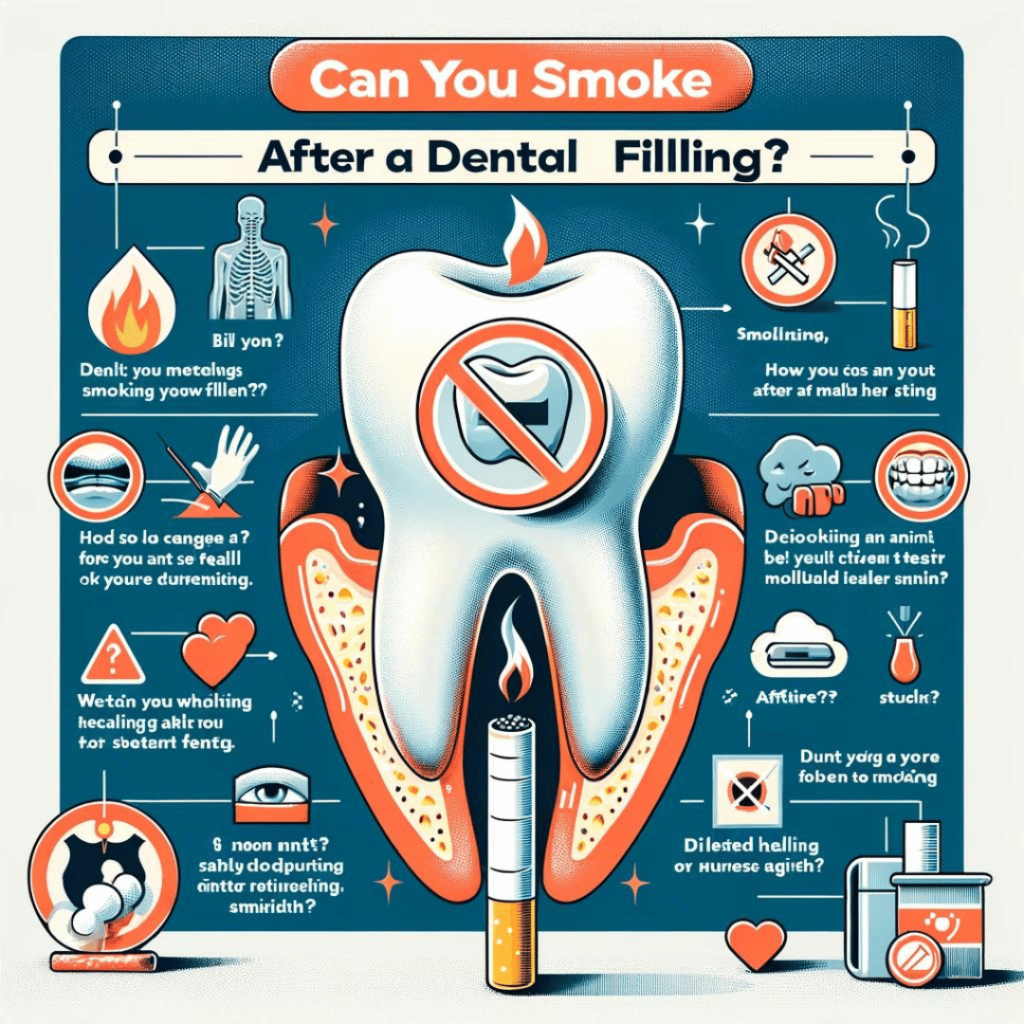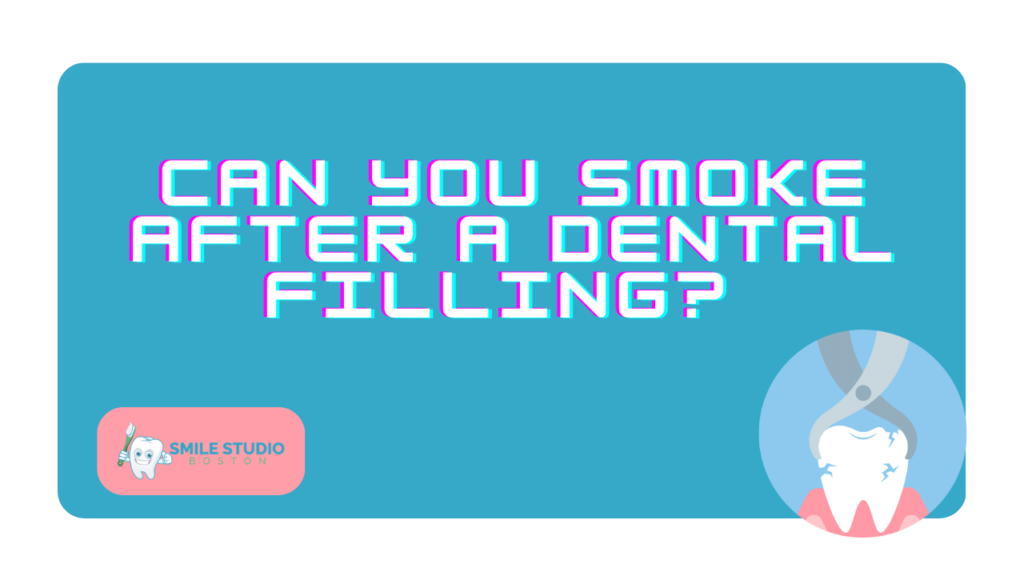Dental fillings are a standard dental treatment, with nearly 90% of adults ages 20 to 64 years having had decay in their teeth. Most adults reported that they had fillings (80%). One common concern that follows after getting a dental filling is about smoking. The question often arises, “Can you smoke after a dental filling?” It’s essential to understand the potential risks associated with smoking after a dental procedure.
Understanding Dental Fillings
Dental fillings restore the integrity and function of a tooth damaged by decay or fracture. They are essential for addressing various dental issues, including cavities, cracks, and tooth decay. The primary purpose of a filling is to return the tooth to its standard shape and function and to prevent further decay by eliminating areas where bacteria can enter.
There are several types of materials used in dental fillings. These include gold, porcelain, silver amalgam (mercury mixed with silver, tin, zinc, and copper), tooth-colored, plastic, and glass materials called composite resin fillings. Each type of filling material has its own advantages and disadvantages, and the choice of material can depend on various factors, such as the location and extent of the decay, the cost of filling material, and the dentist’s recommendation.
Can you smoke after a dental filling? The answer is no. It’s important to note that smoking can significantly delay the healing process after a tooth filling. The chemicals in cigarettes can reduce blood flow and oxygen levels in the mouth, impairing the body’s ability to heal efficiently. Therefore, it is strongly recommended to refrain from smoking after dental fillings. By avoiding smoking, you can promote faster healing, reduce sensitivity, and ensure the longevity of your dental restorations.
Immediate Aftercare: The First 24 Hours
The first 24 hours after receiving a dental filling are crucial for healing. Here are some key points find the answer: can you smoke after a dental filling?
1. Avoid Smoking: It’s strongly recommended to refrain from smoking after a dental filling. The chemicals in cigarettes can reduce blood flow and oxygen levels in the mouth, impairing the body’s ability to heal efficiently.
2. Pain Management: If you experience discomfort after the procedure, over-the-counter pain relievers like ibuprofen and acetaminophen can be used.
3. Dietary Considerations: Stick to a soft diet immediately after the procedure. Avoid hard, crunchy, or sticky foods disturbing the treated area.
4. Oral Hygiene: Continue brushing and flossing, but be gentle around the new filling. Rinse your mouth after meals to remove food particles.
5. Regular Check-ups: Attend routine check-ups so that the dentist can assess the progress of the fillings.
Can You Smoke After a Dental Filling?
Smoking has a significant impact on dental health and specifically on dental fillings:
1. Delayed Healing: Smoking can significantly delay the healing process after a tooth filling. This can increase the risk of infection and complications.
2. Increased Risk of Filling Failure: Studies have shown that smokers are at a higher risk of experiencing dental filling failure compared to non-smokers. The harmful chemicals in cigarettes can weaken the tooth structure and compromise the integrity of dental fillings.
3. Discoloration of Fillings: The chemicals in tobacco smoke can cause discoloration of the filling material, leading to an unsightly appearance.
4. Long-term Oral Health Effects: Smoking is linked with numerous adverse health effects, including gum disease, tooth loss, and oral cancer⁸. It can also reduce the success rates of dental treatments, such as dental implants, root canals, and periodontal surgeries.
In conclusion, while it might be tempting to smoke after getting a dental filling, the potential risks and long-term effects on oral health make it advisable to refrain from doing so.
Comprehensive Post-Filling Care Guide
After getting a dental filling, it’s important to follow a comprehensive care guide to ensure the longevity of the filling and maintain optimal oral health. Here are some key points to consider:
1. Oral Hygiene Practices: Brush your teeth at least twice a day for two minutes using fluoride toothpaste. Incorporate gentle flossing or interdental cleaning techniques to eliminate plaque and food scraps between teeth and filling. Regular dental visits also help your dentist detect and treat problems early before they worsen.
2. Avoid Smoking: It’s strongly recommended to refrain from smoking after a dental filling. The chemicals in cigarettes can reduce blood flow and oxygen levels in the mouth, impairing the body’s ability to heal efficiently.
3. Dietary Recommendations: Stick to a soft food diet immediately after the procedure. Examples of soft foods include applesauce, avocado, baby food, baked beans, bananas, biscuits (soaked or soft biscuits only), bread (soaking in a soup can make for a delicious, filling snack), broth (warm, not hot), cheesecake, clams, cold cereal (soaked until soft), cookies (soaked in milk), cottage cheese, custard, deli meats, eggs, fish, Greek yogurt, ground chicken, hummus, ice cream, jello, juice, macaroni and cheese, mangos, mashed potatoes, mashed vegetables, meatballs, meatloaf, milkshakes (make sure to consume using a spoon, not a straw), mousse, oatmeal (warm oatmeal can be a filling, nutritious food that doesn’t require effort to chew), popsicles, pudding, pumpkin, rice, risotto, salmon, semolina, sherbet, smoothies (avoid including nuts, seeds, or ice), soups, spaghetti, sweetbreads, tapioca, tea, tofu, vegetables (only steamed or well-cooked), waffles (can be soaked), and yogurt.
4. Foods to Avoid: After undergoing a tooth filling treatment, it’s best to avoid foods that are sticky, hard, or very hot or cold. Since your teeth are still recovering, chewing or ingesting these items can cause pain, trigger other dental complications, and dislodge your filling (which may require another visit to your local dental office).
By understanding the factors influencing how long to eat after a filling and following the guidelines provided, you can ensure the longevity and effectiveness of your dental fillings. Remember to be patient, start with soft foods, and gradually reintroduce regular foods as your mouth adjusts.
Dealing with Sensitivity and Discomfort
After getting a dental filling, it’s not uncommon to experience temporary sensitivity and discomfort. This typically occurs when the tooth nerves react to the filling material or the procedure itself. Here are some practical tips to manage this:
1. Pain Management: Over-the-counter pain relievers such as ibuprofen or acetaminophen can be used to manage discomfort.
2. Oral Hygiene: Brush your teeth gently with a soft-bristled toothbrush to avoid irritating sensitive areas. Use fluoride toothpaste to strengthen tooth enamel and protect against decay, which can exacerbate sensitivity.
3. Dietary Adjustments: Avoid consuming extremely hot or cold foods and beverages, as they can trigger sensitivity in recently filled teeth. Acidic foods and drinks, such as citrus fruits and sodas, can irritate sensitive teeth and should be consumed in moderation.
4. Avoid Smoking: Refraining from smoking after a dental filling can help reduce sensitivity and promote faster healing.
If the sensitivity does not subside after two weeks, or if the pain is severe, persistent, or worsening, it’s critical to consult your dentist⁸. They can assess if the pain is due to issues like a high filling, an underlying crack in the tooth, or an infection⁸. Remember, effective communication with your dentist is crucial for managing post-filling sensitivity.

Exploring Alternatives to Smoking
If you’re struggling with cessation after a dental filling, there are several alternatives to smoking that can help:
1. Nicotine Replacement Therapies (NRTs): These include patches, sprays, gum, and lozenges. NRTs provide nicotine without the other harmful chemicals in tobacco, helping to relieve some of the physical withdrawal symptoms so you can focus on the psychological aspects of quitting.
2. Healthy Distractions: Engage in activities that distract you from the urge to smoke. This could be anything from drinking a glass of water, eating a dill pickle, sucking on a piece of tart candy, to practicing smiling in the mirror.
3. Professional Help: Consider seeking help from professionals such as therapists or support groups. They can provide valuable advice and strategies to help manage cravings and maintain a smoke-free lifestyle.
4. Prescription Medicines: Certain prescription medicines can help reduce cravings and withdrawal symptoms. Always consult with a healthcare provider before starting any new medication.
Remember, quitting smoking is a journey that requires patience and perseverance. It’s okay to seek help and explore different methods until you find what works best for you.
The Role of Regular Dental Check-Ups
Regular dental check-ups play a crucial role in maintaining the health of your dental fillings and overall oral health:
1. Early Detection of Issues: Regular dental check-ups can help catch concerns early on before problems become worse. This not only saves you time but also money. Preventive dental care can even be life-saving, for example, when diseases such as oral cancer are found and treated in the early stages.
2. Preventive Care: Regular dental visits ensure that your teeth and gums are in good condition, and that there are no rough edges to make cleaning difficult. Your dentist will also make sure that all your fillings are in good condition.
3. Follow-Up Visits: A dental follow-up is usually scheduled a couple of weeks after a dental procedure. This is performed to check for any complications that can result in potentially lasting damage to the patient’s teeth.
4. Oral Health Connection: In order to be healthy overall, your oral health must be in check, too. The mouth is the gateway into the rest of the body, and dental infection can travel to other areas of the body.
Remember, your oral health impacts your overall health, so prioritize those dental appointments and embrace the benefits of a healthy smile that lasts a lifetime.
Encouraging a Smoke-Free Lifestyle for Oral Health
Quitting smoking is one of the most important actions people can take to improve their health. This is true regardless of their age or how long they have been smoking. Quitting smoking improves health status, enhances quality of life, reduces the risk of premature death, and can add as much as 10 years to life expectancy. It also reduces the risk for many adverse health effects, including poor reproductive health outcomes, cardiovascular diseases, chronic obstructive pulmonary disease (COPD), and cancer.
Real stories from people who have quit smoking can serve as powerful motivation. For instance, the CDC’s Tips From Former Smokers® campaign shares stories of people living with smoking-related diseases and disabilities. These individuals speak from personal experience and send a single, powerful message: Quit smoking now.
FAQs
1. How long after tooth filling can you smoke?
It’s generally advised to refrain from smoking for at least 24 hours after getting a dental filling. However, some sources suggest waiting for at least 2-3 hours or even up to 72 hours.
2. Can smoking damage fillings?
Yes, smoking can damage fillings. The harmful chemicals present in cigarettes, such as nicotine and tar, can weaken the tooth structure and compromise the integrity of dental fillings. Smoking can also increase the risk of dental filling failure.
3. Can you vape after tooth filling?
Similar to smoking, it’s generally advised to refrain from vaping after getting dental fillings. Vaping can have potential risks and complications for your dental fillings and overall oral health.
4. What not to do after getting a filling?
After getting a filling, it’s recommended to avoid any hard, chewy, or sticky foods for up to two weeks. You should also avoid very hot or cold foods and beverages for a few days to a week or two. It’s also important to continue brushing your teeth and flossing regularly.
5. What happens if you smoke right after a filling?
Smoking right after a filling can increase the pain at the tooth extraction site, slow down the healing process, and leave you more susceptible to infection and complications.
6. What happens if you smoke after the dentist?
Smoking after a dental procedure can slow down the healing process, increase the risk of developing infections, and cause more pain at the site of the procedure. It can also cause the gums to recede, which can loosen the filling.


